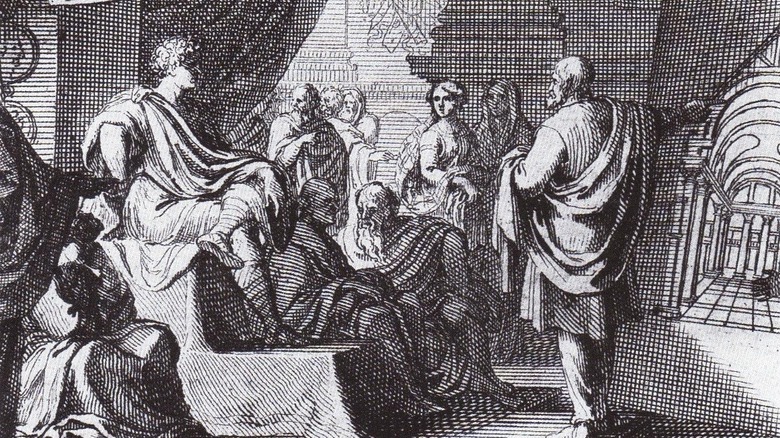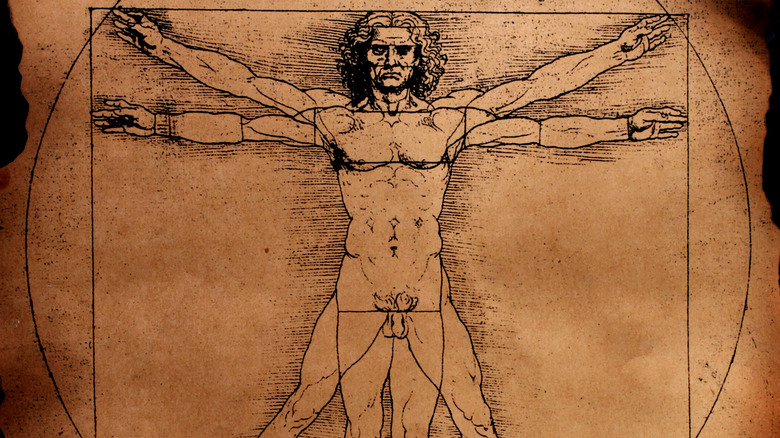One Of Leonardo Da Vinci's Most Famous Drawings Has Been Fooling Us This Whole Time
If you're at all familiar with Leonardo da Vinci (above) beyond his namesake in the Teenage Mutant Ninja Turtles franchise, you probably know him for one or both of two things: the Mona Lisa, which has been a source of inspiration and parody for centuries, or the Vitruvian Man, a diagram of the male form inside a circle.
The Vitruvian Man sketch has become a sort of visual shorthand for art, or for the Renaissance, or for anatomy, in much the same way that e=mc2 is visual shorthand for physics. It's a sort of metaphor for everything da Vinci was about: the perfection of the human form as it relates to art; the "perfect" proportions of a man as it relates to geometry and anatomy. It's like art and science — two of da Vinci's passions — rolled into one visual reference.
And da Vinci wasn't the first to come up with the idea. It's literally named for the Roman thinker who came up with it, Vitruvius, although his description appears to be limited to words rather than sketches. Further still, da Vinci wasn't the first to draw the Vitruvian Man, although his drawing is by far the most well known.
Vitruvius Starts The Show
Travel back with us to the height of the Roman Empire, where magnificent buildings, temples, forums, and other works ruled the day. So solidly-built were those Roman structures that many — the Coliseum, the Pantheon, various aqueducts — still stand today, 2,000 years later, in various stages of disrepair. These things were, of course, designed and built by architects, utilizing the same fundamental principles that guide architecture today.
Vitruvius was, if not chief among them, certainly one of the most important architects of his day (the 1st century B.C.), according to Britannica. His book, "De Architectura" ("On Architecture"), was like Julia Child's "Mastering the Art of French Cooking," only for Roman architecture and not French cuisine.
In the book, provided via the University of Chicago, Vitruvius describes the ideal portions of a man as an example of the importance of symmetry in architecture, and in a broader sense, nature and the universe in general. We'll spare you the minutiae, but long story short, da Vinci was very interested in this concept, according to the Metropolitan Museum of Art, expanding on it and providing what he believed would have been Vitruvius' measurements.
Da Vinci Was Late To The Game
As far as anyone knows, Vitruvius' description of his ideal man is limited to words and not drawings; if he did sketch a drawing, it's lost to history.
Leonardo da Vinci would sketch one approximately 1,500 years later, but as it turns out, he wasn't the first to take a crack at it. He probably put pen to paper some time around 1490, according to Art In Context, but other thinkers beat him to the concept by at least a century. We know this because, according to Smithsonian Magazine, back in 1986 a researcher named Claudio Sgarbi was leafing through a copy of Vitruvius' book, and within he found dozens of drawings, including a crude (compared to da Vinci's) take on Vitruvian Man, dating at least a century earlier. Further still, a decade before da Vinci took a crack at it, architect Francesco di Giorgio Martini also composed a rather, shall we say, "loose" diagram of Vitruvian Man that got just about everything wrong.
Da Vinci himself might have even had some help with his drawing, according to Art and Object, which claims that his contemporary, Giacomo Andrea de Farrara, may have lent a hand.


